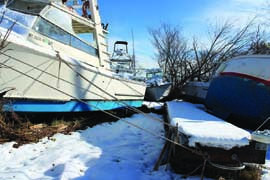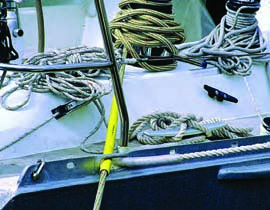by BETH LEONARD

With many areas still recovering from Sandy, hurricane season is upon us once again. Here are the resources you need to be prepared.
Superstorm Sandy, which walloped the Northeast coast in October 2012, reminded all of us that surge can cause at least as much damage as wind. Sandy’s surge, which exceeded 10 feet in the hardest hit areas like Staten Island and northern New Jersey, overwhelmed the infrastructure at hundreds of marinas, floating docks off pilings, destroying fixed docks, and carrying away boats on the hard.

Though these boats were prepared well with canvas removed and doubled lines, the surge in Sandy lifted their floating docks right off their pilings. © BoatUS Marine Insurance
It would be easy to conclude that preparations didn’t matter this time around, that nothing could have prevented the devastation. But that would be the wrong lesson to take from Sandy. Our research shows that boats stood a much higher chance of surviving where marinas and boat owners prepared for the surge specifically. The real lesson to take from Sandy is that the right preparations, designed to address the real risks, can and do work. So, with the 2013 tropical cyclone season upon us, let’s look at what you should do to beat the odds should a hurricane come calling.
1. Assess the risks for where your boat is stored during a hurricane.
If the odds are against you, look for another place. Ideally, you’d like to understand the overall risk of wind and surge in the future at the exact spot where you keep your boat during storms. But that’s not information you can look up on the Internet. To get some idea of your risks, you’ll have to rely on historical data.
Between 1900 and 2012, the Northeast has only experienced one hurricane with high winds every 22 years on average, with none stronger than Category 3. The Gulf Coast and Florida, on the other hand, have been hit with a Category 3 or higher hurricane every three to five years over the past 112 years.
So, if you keep your boat in the Gulf Coast or Florida, you need to make sure the place where you secure your boat during a storm can withstand 100-knot and higher winds. If your boat is in a marina, find out if they’ve ever had winds that strong in the past, and how much wind the marina is designed to survive.
The National Weather Service is working on a tropical-storm surge-inundation tool that will predict surge heights above ground level for individual properties, but that won’t be operational until 2014.
If you live in the storm-damaged areas of New York or New Jersey, the Federal Emergency Management Agency’s (FEMA) Advisory Base Flood Elevation (ABFE) tool (online at region2coastal.com/sandy/abfe/property_owners) provides the recommended elevation of the lowest floor of a building in a given area, which reflects FEMA’s assessment of surge/flood risk for that area. If you live in other areas, you can use the National Hurricane Center’s Sea, Lake, and Overland Surges from Hurricanes (SLOSH) Model (nhc.noaa.gov/surge/slosh.php) to look at storm surges from past storms. While it’s cumbersome to download the model and run it yourself, simulations of several previous storms are available on the website. The highest water level recorded in your area in past storms will give you some sense of your surge risk.
You can use that surge height to evaluate the place where you’d keep your boat if a hurricane threatened. If you’re on a floating dock, are the pilings high enough? Or would the surge float the docks off the pilings? How high would the water be in the hardstand area? High enough to lift your boat off its jackstands? Would there be waves in the hardstand area? If you’re not happy with the answers, find another place to keep your boat during a storm.
2. Get a copy of your marina’s hurricane plan and review it carefully.
You need to understand your obligations, and theirs. To see some sample hurricane plans from marinas around the country, visit BoatUS.com/hurricanes.
3. Determine where to get the most accurate forecasts for wind and surge.
Once a storm is approaching, your preparations will depend upon the forecast for wind or surge in your area. The National Weather Service and National Hurricane Center remain the best source of information when a storm threatens the coast. Sign up now to get hurricane alerts based on those forecasts sent directly to your inbox from the BoatUS Hurricane Center.
The National Weather Service plans to begin issuing surge forecasts in addition to the Saffir-Simpson scale wind forecasts for all major storms sometime in 2014. Their Probabilistic Inundation Surge Height (PHISH) model (slosh.nws.noaa.gov/phish/about.php) is fully operational and forecasts surge when a hurricane is threatening an area. Your storm preparations should take into account not just the forecast wind but also the forecast surge.

Proper hurricane preparation includes doubling lines and adding chafe protection. These docklines are led through sections of heavy-duty water hose. © BoatUS Marine Insurance
4. Create your own hurricane plan.
Stripping off sails and canvas, doubling lines on boats left in the water, lengthening scope on moorings, and even tying the boat down if it’s on land can make the difference between a boat surviving a storm and not. The BoatUS Hurricane Center has a whole section on boater prep, including a hurricane preparation worksheet that can help you figure out what you should do before the storm arrives. The West Marine Hurricane Resources page has a useful video that walks you through storm prep.
5. Check your insurance policy for salvage, wreck removal, and fuel-spill liability.
As too many people discovered after Sandy, it pays to read the fine print in your insurance policy to make sure you’re covered in the event you need salvage or wreck removal after the storm. The best policies cover the cost of salvage, without deducting it from the payment to you for damages to the boat, and offer additional coverage for wreck removal under the policy’s liability provisions. They also provide the federal maximum of $854,400 of fuel-spill coverage separate from your boating liability (Protection and Indemnity or P&I) coverage, and will pay for fuel-spill damage even if doesn’t result from a covered loss.
Beth Leonard is the Technical Editor for BoatUS publications and Assistant Director of Technical Services. She is the author of The Voyager’s Handbook, a how-to guide for those who want to head offshore in their own boats, and narratives about her two circumnavigations: Blue Horizons, and Following Seas.
This article was originally published in the June/July 2013 issue of Seaworthy magazine, the BoatUS Marine Insurance publication dedicated to helping members avoid injury and boat damage due to accidents and storms, and is reprinted with permission. Special thanks to Scott Croft, AVP Public Relations at BoatUS.




